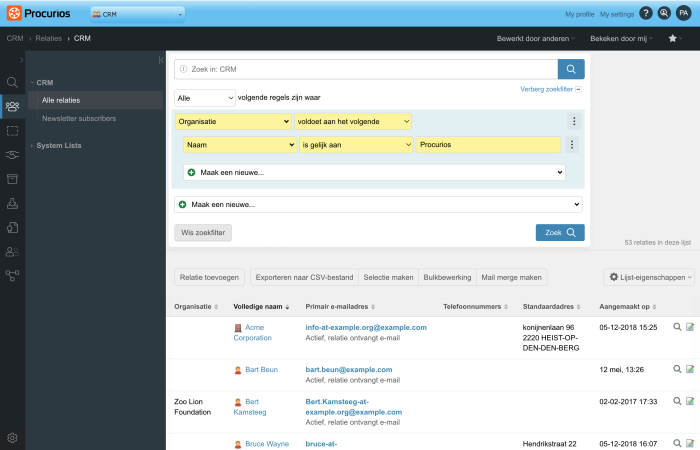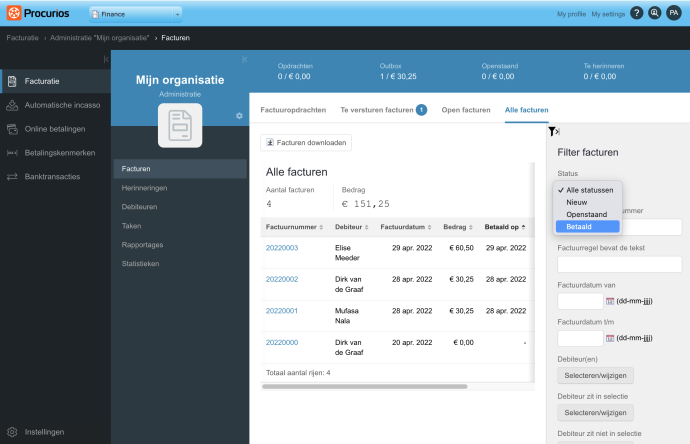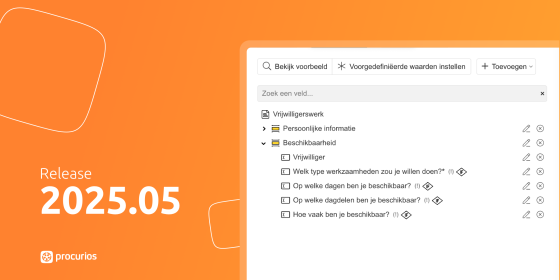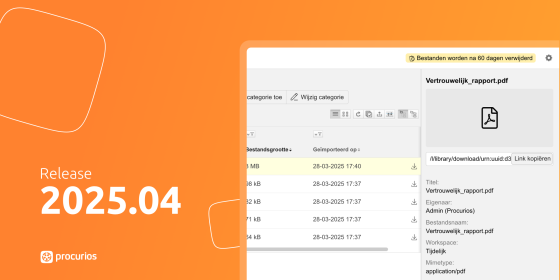Release 2022.08
In de loop van woensdag 20 juli 2022 maken alle klanten op de productieversie van het Procurios Platform gebruik van release 2022.08. In dit blog lees je wat nieuw is en wat is verbeterd. Kijk voor meer informatie over de verschillende versies van het platform op de release pagina of schrijf je in voor één van de release webinars.

Memberships: online registratie voor abonnementen
Tot deze release moest een medewerker een abonnement nog handmatig invoeren nadat er online een nieuw abonnement (of lidmaatschap) geregistreerd is. Dat kan efficiënter, daarom is het nu mogelijk om dit automatisch te laten plaatsvinden.
Let op: deze module is niet automatisch toegevoegd aan je Platform. Vraag je consultant hier om.
Binnen Memberships kun je onder Instellingen aangeven welke abonnementsopties online gekozen kunnen worden. Hier kun je kiezen uit persoonlijke abonnementen of bedrijfsabonnementen, dus een abonnement voor het bedrijf waar een registrant werkt. Ook richt je hier een bevestigingsmail in.
Binnen Profiel- & Registratie zijn nieuwe velden beschikbaar gekomen waarmee je je formulier kunt inrichten zoals door jou is gewenst. En via twee nieuwe artikeltypes zijn de formulieren vervolgens te publiceren via CMS.
Het resultaat van een registratie is een actief abonnement waar je (administratief gezien) geen omkijken meer naar hebt.
TIP: Houd je Platform opgeruimd. Werkte je tot op heden met statusvelden en relatielijsten voor de verwerking van nieuwe abonnementsregistraties? Verwijder deze dan definitief zodra je ze niet meer nodig hebt.

API: meeting (v2)
De API voor Bijeenkomsten (v2) is uitgebreid. Veel hiervan is technisch van aard, om het overzichtelijk te houden vind je onderstaand een korte opsomming van wijzigingen:
- Info over deelnemer (Attendee endpoint): naast de volledige naam worden nu ook de afzonderlijke naamvelden en ook de naam van de organisatie meegegeven.
- Nieuwe endpoint voor locaties, hiermee kan informatie van de locaties opgehaald worden.
- Eigenschappen van een registratie:
- Is registratie mogelijk? Op basis van instellingen op Tickets.
- Is annuleren mogelijk? Zo ja, tot wanneer?
-
Toegevoegd:
-
- Coverfoto
- Aanwezigheidsmodus - ‘waar’ vindt een bijeenkomst plaats: online, offline of hybride?
- Labels
5. Filters die op de frontend kunnen worden gebruikt, kunnen nu ook via de API gebruikt worden
De volledige (technische) documentatie over onze API’s vind je hier terug: https://api.procurios.com/api_documentation.
CRM: activatiemail voor meerdere soorten gebruikers
Bij het handmatig aanmaken van een nieuwe Gebruiker (=iemand die kan inloggen) vanuit de backend van het Platform* moet je aangeven voor welke site (backend of frontend site) je hem gebruiker maakt en wat zijn ‘fallback’taal is. De nieuwe gebruiker krijgt dan een activatiemail gebaseerd op een vooraf ingesteld e-mailcontentsjabloon.
Als alle gebruikers allemaal eenzelfde activatiemail mogen ontvangen gaat dat goed. In de praktijk van sommige organisaties is er sprake van meerdere soorten gebruikers die op een afzonderlijke wijze benaderd moeten worden.
Via CRM > Instellingen > Gebruikersaccounts kun je nu meerdere variaties inrichten voor verschillende soorten gebruikers. De e-mailsjabloontekst is verplaatst naar deze pagina, wat er voor zorgt dat je voor iedere groep een eigen e-mailtekst kunt opgeven. Deze e-mailtekst is vertaalbaar gemaakt. Een gebruiker krijgt dan de mail in de taal die is opgegeven als voorkeurstaal. Is er geen voorkeurstaal bekend, dan zal de fallback-taal uit deze nieuwe configuratie gebruikt worden.
Als je bij een Relatie kiest voor ‘Maak gebruiker’, dan hoef je nu alleen nog maar het gebruikerstype te kiezen. Op basis daarvan wordt dan de vooraf ingestelde activatiemail verstuurd naar de nieuwe gebruiker.
Zolang er geen Configuratie op deze nieuwe manier is ingericht zal de oude methode blijven functioneren. Bij het aanmaken van een eerste Configuratie vervalt automatisch de oude werkwijze en is de nieuwe werkwijze van kracht.
*) Deze ontwikkeling betreft niet de activatiemail die wordt verstuurd vanuit een Registratieformulier.

CRM: telefoonvelden bij Organisaties & Personen
Het was al mogelijk om bij het instellen van Organisaties & Personen verschillende e-mailtypen beschikbaar te maken, maar bij telefoontypen was het alleen mogelijk om het veld ‘Telefoonnummers’ te gebruiken. Je kunt nu instellen welke telefoontypen (vast, mobiel, werk) er beschikbaar moeten zijn binnen Profiel & Registratie.

CRM: zoeken op Organisatie
Binnen CRM bij Organisaties & Personen (CRM > Instellingen > Organisaties & Personen) kun je expliciet maken wat de definitie organisatie-persoon inhoudt. Bijv. Medewerker > Organisatie. Het systeem maakt op verschillende plekken gebruik van deze definitie. Onder andere de Organisatievelden in het CRM bij exporteren.
Het is vanaf nu ook mogelijk om deze definitie te gebruiken bij Zoeken in het CRM. Op deze manier krijg je bij het zoeken binnen het CRM dezelfde resultaten als op andere plekken waar Organisaties & Personen wordt gebruikt.

CMS: vertalingen binnen Twig in Website Templates
De vertalingen van teksten die binnen HTML, Javascript of YML bestanden van een website template staan konden tot nu toe al worden beheerd. Het was echter nog niet mogelijk om teksten die binnen een van de Twig-bestanden stonden zelf te vertalen. Die mogelijkheid is nu toegevoegd, zodat je via het item ‘Vertalingen’ binnen het beheer van de template zelf de Twig-teksten kunt vertalen.

CMS: zoeken in weblog
De websitezoekfunctie was al in staat om - naast artikelen - weblogberichten te indexeren en zoekbaar te maken. In sommige situaties is een bezoeker alleen op zoek naar een specifiek blogbericht. Je kunt nu via Filters een nieuw zoekfilter toevoegen dat alleen binnen de tekst van weblogberichten in een blogoverzicht zoekt.

Finance: verbeteringen in Finance
Binnen het onderdeel Invoices was het al mogelijk om meerdere administraties te hebben zodat er gefactureerd kan worden per administratie. Deze administraties kwamen nog niet binnen alle onderdelen van Finance terug (zoals bij het verwerken van transacties). Om dit mogelijk te maken zijn zowel de indeling van Finance als de plek waar je deze administraties kunt beheren uit Invoices gehaald. Hierdoor is het mogelijk om alle financiële processen te beperken op een specifieke administratie.
Met deze verbeteringen zijn een paar onderdelen verplaatst: ‘Alle facturen’ is nu terug te vinden binnen de administratie. Klanten met één administratie hoeven niet eerst de administratie te kiezen: deze stap wordt dan overgeslagen. In het menu van Finance hebben alle onderdelen van het financiële proces een plek gekregen.


Meetings & Events: overzicht van afdelingsbijeenkomsten publiceren
Als er gebruik wordt gemaakt van afdelingsbijeenkomsten was het al mogelijk om bijeenkomsten expliciet te koppelen aan een afdeling. Het was nog niet mogelijk om op een afdelingswebsite een overzicht van deze bijeenkomsten te publiceren. Hiervoor is een instelling binnen het artikel ‘Bijeenkomstenoverzicht’ toegevoegd.











